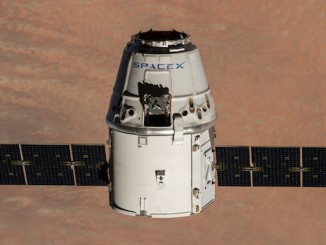
The first pair of RD-181 rocket engines set to launch on Orbital ATK’s redesigned Antares rocket are in the final stages of acceptance testing in Russia ahead of their export to the United States in early July, officials said.
The RD-181 engine completed its certification program May 7 with the last of seven hotfire tests in Russia, according to NPO Energomash of Khimki, Russia, the engine’s manufacturer.
“The testing started in late March and was completed in early May,” said David Thompson, Orbital ATK’s president and CEO, in a quarterly earnings call May 28. “It involved a series of seven certification firings of the engine, all of which went as expected. The first two flight engines are now undergoing acceptance testing.”
Energomash said the certification tests verified the RD-181 engine meets its performance and reliability specifications. The acceptance tests are designed to ensure engines destined for flight meet production standards.
Once the engines pass their preflight checks, Energomash will ship the units to the United States, where technicians will attach them to a modified first stage booster slated to fly on the Antares rocket’s next launch.
The newly-built engines will power Orbital ATK’s Antares rocket on resupply missions to the International Space Station. The first Antares flight with RD-181 engines is scheduled for March 2016, Orbital ATK officials said.
Orbital ATK signed a contract for at least 20 kerosene-fueled RD-181 engines built by NPO Energomash to replace the Antares rocket’s decades-old AJ26 engines, which were manufactured in Russia in the 1970s and exported to the United States in the 1990s before eventually flying on the first stage of Orbital ATK’s booster.
The company blamed one of the engines for a fiery explosion moments after launch in October 2014, which destroyed the Antares rocket and a Cygnus supply ship packed with cargo for the space station.
The failure also damaged the Antares launch pad at Wallops Island, Virginia.

Thompson said modifications to the Antares rocket’s Ukrainian-made first stages are proceeding on schedule, and repairs to the Antares launch complex — owned by the state of Virginia and sitting on federal property — should be finished in September.
“This all adds up to our being able to conduct full system testing late this year and into January of 2016, and to holding an initial launch date for the re-engined Antares in March of 2016 with about one month of schedule margin available to us at this time,” Thompson said.
The new RD-181 engines consume the same propellant mixture as the AJ26 engines previously flown on the Antares rocket. The engine change will give the Antares rocket additional lift capacity, providing a combined 820,000 pounds of thrust at full throttle, more than the twin-engine AJ26 engine configuration could generate.
Orbital ATK and Aerojet Rocketdyne, which upgraded the Russian-built AJ26 engines, have not released a final report on last year’s catastrophic launch mishap.
The failure compelled Orbital ATK to expedite a previously-planned switchover to a new engine for the Antares rocket and contract with United Launch Alliance to send up its next resupply mission to the space station on an Atlas 5 rocket.
Orbital ATK has a contract with NASA worth more than $2 billion for eight cargo deliveries to the space station through 2017, including the failed mission in October, which was the third flight in the eight-launch series.

The contract calls for Orbital ATK to lift 20 metric tons — about 44,000 pounds — of supplies to the space station. Orbital ATK says it can meet the requirement with seven flights using the larger hauling capacity of the Atlas 5 rocket.
NASA announced earlier this year it awarded Orbital ATK a contract extension for one more cargo mission in 2017, bringing the company’s logistics manifest back to eight launches.
The space agency has a similar agreement with SpaceX for 15 resupply flights to the space station.
Thompson said Orbital ATK is one of at least four companies vying for a new NASA contract to cover the space station’s resupply needs through 2020.
Orbital ATK officials said the company is on track to achieve more than $60 million in cost reductions this year — and at least $100 million in savings next year — after the company’s formation in February with the merger of Orbital Sciences and the defense and aerospace divisions of ATK.
Blake Larson, Orbital ATK’s chief operating officer, said more than half of the savings will go toward slashing prices for customers. The rest will go to the company’s stockholders.
According to Larson, the company has cut more than 900 jobs since the merger was first announced last year. Orbital ATK is aiming to rid itself of 500,000 square feet of facility space by mid-2016 as part of the post-merger consolidation.
Email the author.
Follow Stephen Clark on Twitter: @StephenClark1.



